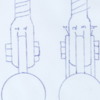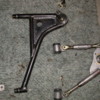I just wanted to get a general concensus on a bolt laoding question I have. In the following poor rendition of my suspension setup you can see my existing setup on the left and my planned one on the right. In the existing setup I use a 3/8 bolt in double shear as indicated by #'s 1 and 2. In the planned setup I would be using the same 3/8 shoulder bolt in quadruple shear as indicated by #'s 1-4. The main stock pivot which I still use utilizes a 1/2 bolt in double shear. Could I not gain more stength on my secondary pivots by using a 3/8 shoulder bolt in quadruple shear than a 1/2 in double. My dilemma is that it would take a lot less remanufacturing and induced cost to modify my existing setup than rebuilding it for 1/2 bolts.
Any insight would be appreciated.
Blaine
Attachments
Original Post



